Business Law Report: Sources of Law, Business Impact, and Disputes
VerifiedAdded on 2020/11/12
|15
|4546
|282
Report
AI Summary
This report, prepared for Global Solicitor, provides a comprehensive overview of business law within the UK legal system. It begins by outlining the various sources of law, including statutory law, common law, equity law, and European law. The report then evaluates the effectiveness of recent legal reforms and developments. It delves into the role of government in lawmaking and how laws are applied, alongside an evaluation of the UK's legal system. Furthermore, the report examines the impact of company, employment, and contract law on businesses, including the differences between legislation, regulations, and standards. It also explores the legal formation, management, and funding of different business organizations, assessing their pros and cons. Finally, the report recommends appropriate legal solutions for resolving disputes, offering examples of how clients can obtain legal advice and support, and compares different sources of legal aid, concluding with a summary of the key findings and recommendations.
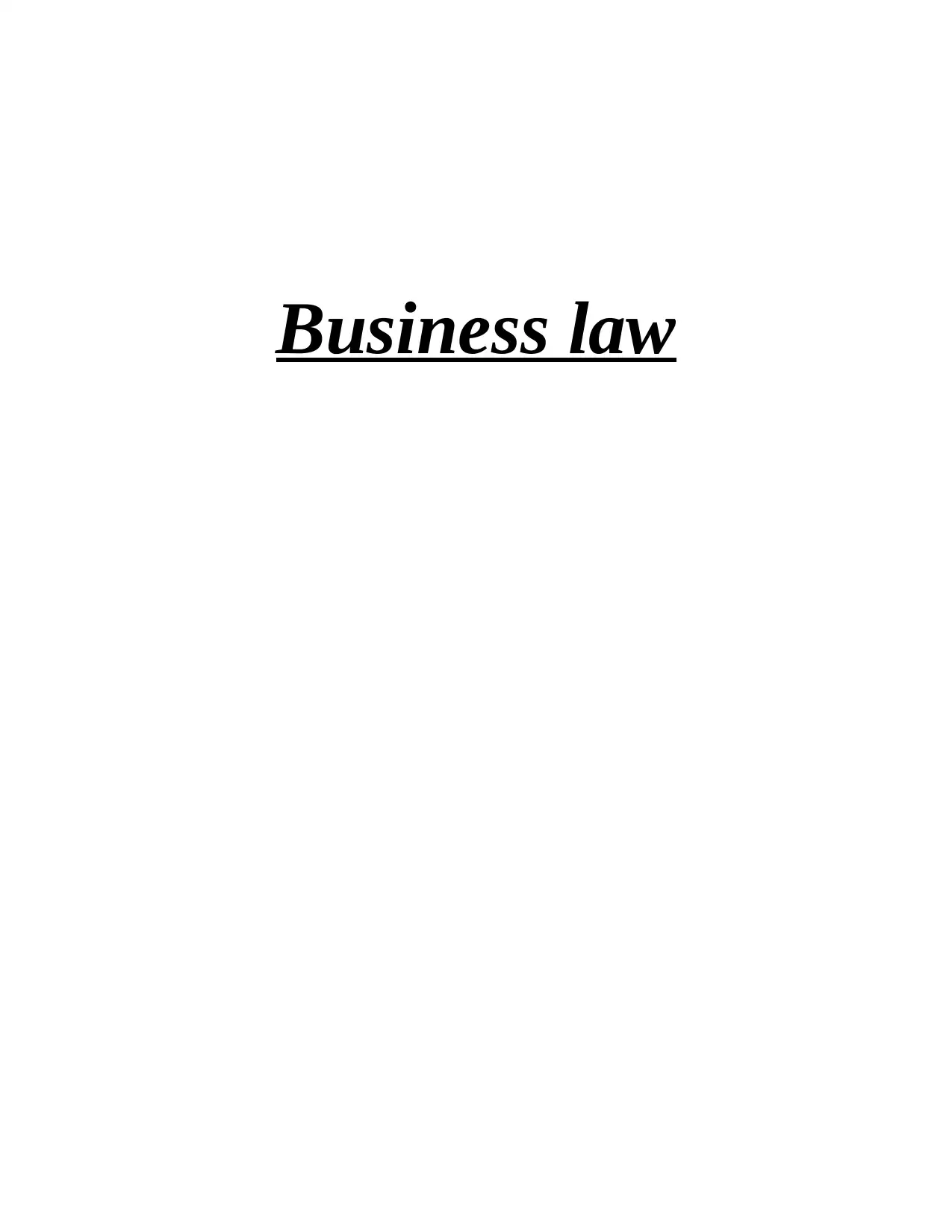
Business law
Paraphrase This Document
Need a fresh take? Get an instant paraphrase of this document with our AI Paraphraser

Table of Contents
INTRODUCTION...........................................................................................................................1
Task 1...............................................................................................................................................1
P1 Different sources of law in UK..............................................................................................1
M1 Evaluation of effectiveness of recent reforms and development in legal system.................2
D1 Evaluation of the legal system and the law...........................................................................2
P2 Role of government in law making and how these are applied.............................................3
Task 2...............................................................................................................................................4
P3 How companies, employment and contract law has potential impact upon business...........4
M2 Differences between legislation, regulations and standards to analysis potential impact
upon business..............................................................................................................................5
Task 3...............................................................................................................................................6
P4 How different types of business organisation are legally formed.........................................6
P5 How these organisations are managed and funded................................................................7
M3 Detailed assessment on the pros and cons of their formation..............................................7
D2 Critical review and an evaluation of the different types of business organisations.............8
Task 4...............................................................................................................................................8
P6 Identification and recommendation of appropriate legal solutions for resolving a range of
disputes using relevant examples to demonstrate how a client might obtain legal advice and
support.........................................................................................................................................8
M4, D3 Including a comparison and evaluation of the different sources of legal advice and
support.........................................................................................................................................9
Conclusion.......................................................................................................................................9
REFERENCES..............................................................................................................................11
......................................................................................................................................................12
.......................................................................................................................................................12
INTRODUCTION...........................................................................................................................1
Task 1...............................................................................................................................................1
P1 Different sources of law in UK..............................................................................................1
M1 Evaluation of effectiveness of recent reforms and development in legal system.................2
D1 Evaluation of the legal system and the law...........................................................................2
P2 Role of government in law making and how these are applied.............................................3
Task 2...............................................................................................................................................4
P3 How companies, employment and contract law has potential impact upon business...........4
M2 Differences between legislation, regulations and standards to analysis potential impact
upon business..............................................................................................................................5
Task 3...............................................................................................................................................6
P4 How different types of business organisation are legally formed.........................................6
P5 How these organisations are managed and funded................................................................7
M3 Detailed assessment on the pros and cons of their formation..............................................7
D2 Critical review and an evaluation of the different types of business organisations.............8
Task 4...............................................................................................................................................8
P6 Identification and recommendation of appropriate legal solutions for resolving a range of
disputes using relevant examples to demonstrate how a client might obtain legal advice and
support.........................................................................................................................................8
M4, D3 Including a comparison and evaluation of the different sources of legal advice and
support.........................................................................................................................................9
Conclusion.......................................................................................................................................9
REFERENCES..............................................................................................................................11
......................................................................................................................................................12
.......................................................................................................................................................12

⊘ This is a preview!⊘
Do you want full access?
Subscribe today to unlock all pages.

Trusted by 1+ million students worldwide
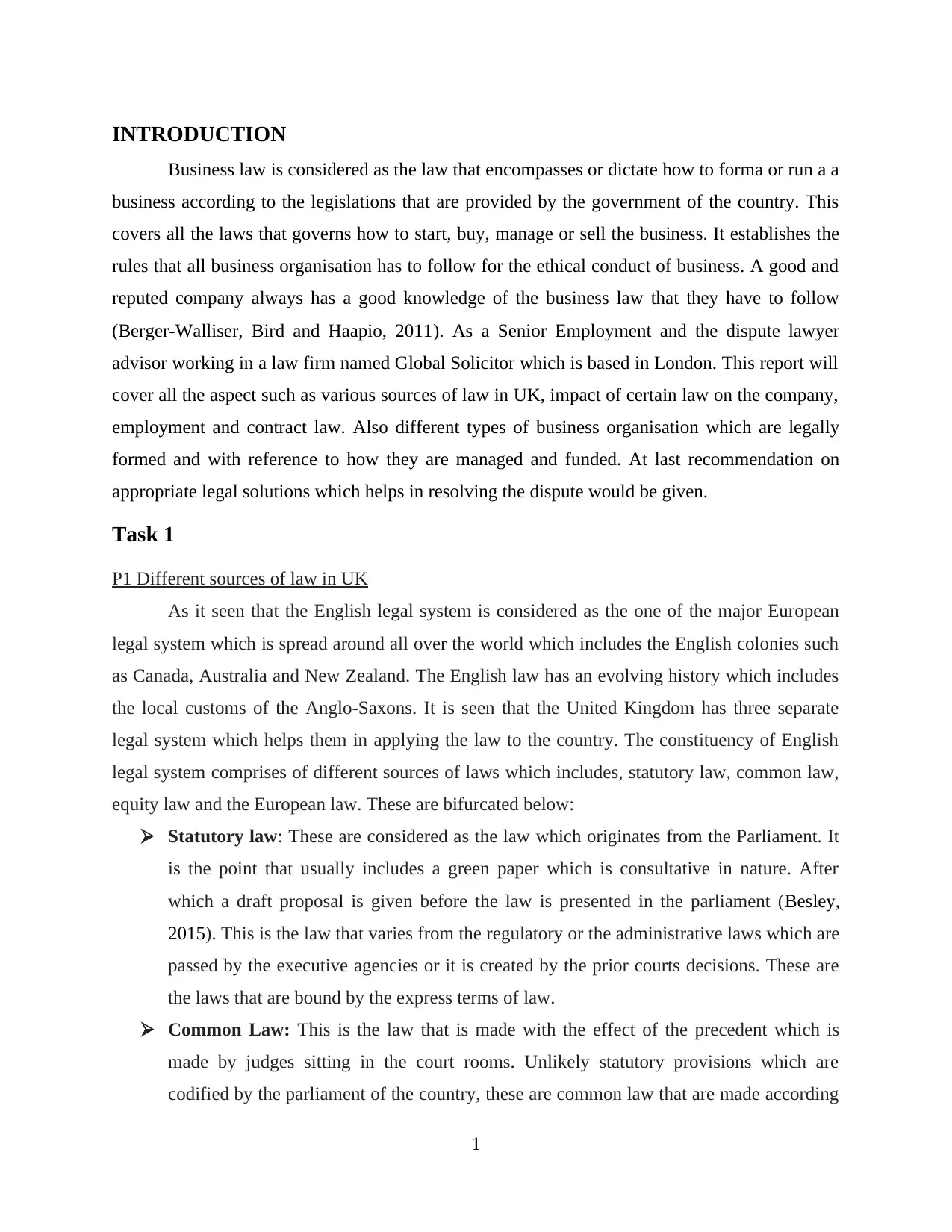
INTRODUCTION
Business law is considered as the law that encompasses or dictate how to forma or run a a
business according to the legislations that are provided by the government of the country. This
covers all the laws that governs how to start, buy, manage or sell the business. It establishes the
rules that all business organisation has to follow for the ethical conduct of business. A good and
reputed company always has a good knowledge of the business law that they have to follow
(Berger-Walliser, Bird and Haapio, 2011). As a Senior Employment and the dispute lawyer
advisor working in a law firm named Global Solicitor which is based in London. This report will
cover all the aspect such as various sources of law in UK, impact of certain law on the company,
employment and contract law. Also different types of business organisation which are legally
formed and with reference to how they are managed and funded. At last recommendation on
appropriate legal solutions which helps in resolving the dispute would be given.
Task 1
P1 Different sources of law in UK
As it seen that the English legal system is considered as the one of the major European
legal system which is spread around all over the world which includes the English colonies such
as Canada, Australia and New Zealand. The English law has an evolving history which includes
the local customs of the Anglo-Saxons. It is seen that the United Kingdom has three separate
legal system which helps them in applying the law to the country. The constituency of English
legal system comprises of different sources of laws which includes, statutory law, common law,
equity law and the European law. These are bifurcated below:
Statutory law: These are considered as the law which originates from the Parliament. It
is the point that usually includes a green paper which is consultative in nature. After
which a draft proposal is given before the law is presented in the parliament (Besley,
2015). This is the law that varies from the regulatory or the administrative laws which are
passed by the executive agencies or it is created by the prior courts decisions. These are
the laws that are bound by the express terms of law.
Common Law: This is the law that is made with the effect of the precedent which is
made by judges sitting in the court rooms. Unlikely statutory provisions which are
codified by the parliament of the country, these are common law that are made according
1
Business law is considered as the law that encompasses or dictate how to forma or run a a
business according to the legislations that are provided by the government of the country. This
covers all the laws that governs how to start, buy, manage or sell the business. It establishes the
rules that all business organisation has to follow for the ethical conduct of business. A good and
reputed company always has a good knowledge of the business law that they have to follow
(Berger-Walliser, Bird and Haapio, 2011). As a Senior Employment and the dispute lawyer
advisor working in a law firm named Global Solicitor which is based in London. This report will
cover all the aspect such as various sources of law in UK, impact of certain law on the company,
employment and contract law. Also different types of business organisation which are legally
formed and with reference to how they are managed and funded. At last recommendation on
appropriate legal solutions which helps in resolving the dispute would be given.
Task 1
P1 Different sources of law in UK
As it seen that the English legal system is considered as the one of the major European
legal system which is spread around all over the world which includes the English colonies such
as Canada, Australia and New Zealand. The English law has an evolving history which includes
the local customs of the Anglo-Saxons. It is seen that the United Kingdom has three separate
legal system which helps them in applying the law to the country. The constituency of English
legal system comprises of different sources of laws which includes, statutory law, common law,
equity law and the European law. These are bifurcated below:
Statutory law: These are considered as the law which originates from the Parliament. It
is the point that usually includes a green paper which is consultative in nature. After
which a draft proposal is given before the law is presented in the parliament (Besley,
2015). This is the law that varies from the regulatory or the administrative laws which are
passed by the executive agencies or it is created by the prior courts decisions. These are
the laws that are bound by the express terms of law.
Common Law: This is the law that is made with the effect of the precedent which is
made by judges sitting in the court rooms. Unlikely statutory provisions which are
codified by the parliament of the country, these are common law that are made according
1
Paraphrase This Document
Need a fresh take? Get an instant paraphrase of this document with our AI Paraphraser
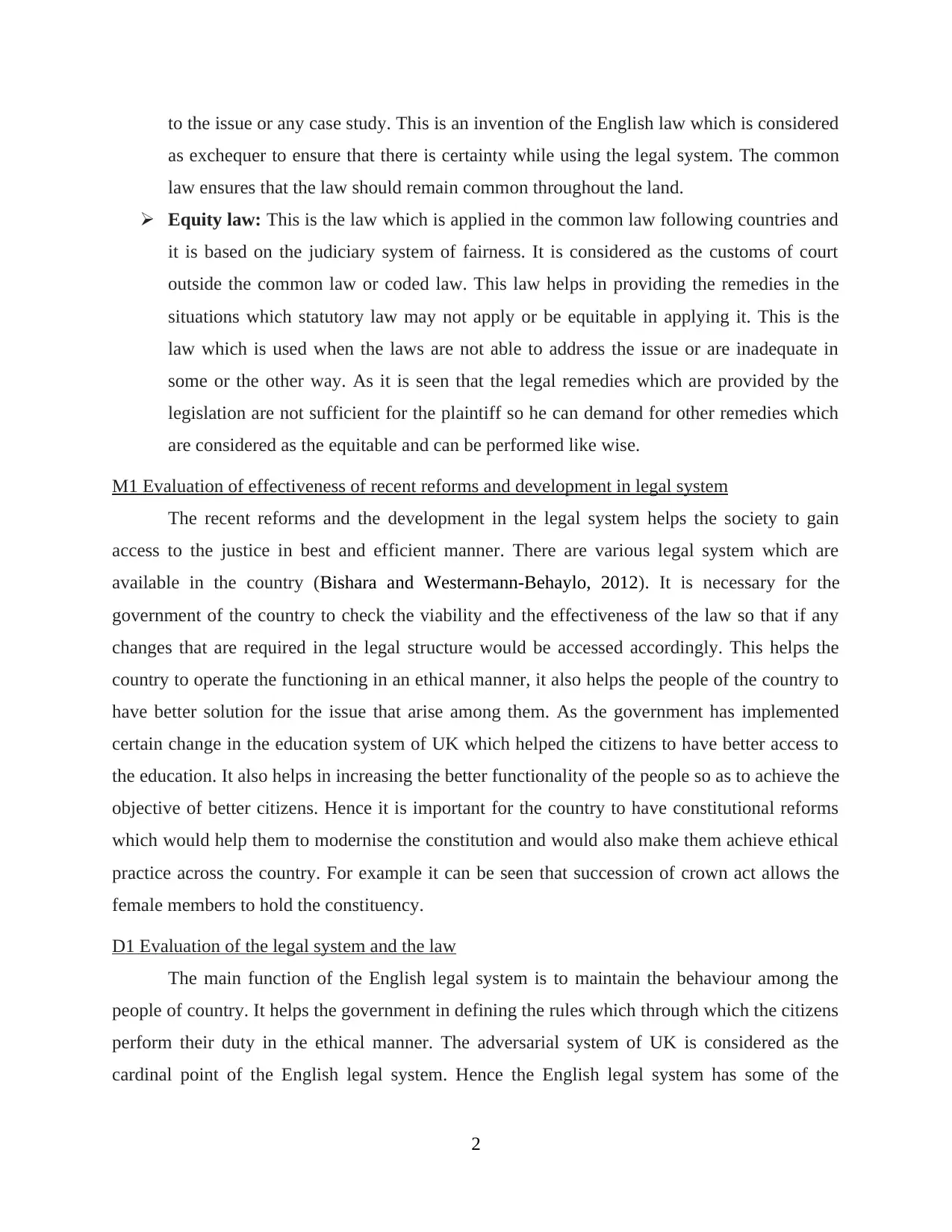
to the issue or any case study. This is an invention of the English law which is considered
as exchequer to ensure that there is certainty while using the legal system. The common
law ensures that the law should remain common throughout the land.
Equity law: This is the law which is applied in the common law following countries and
it is based on the judiciary system of fairness. It is considered as the customs of court
outside the common law or coded law. This law helps in providing the remedies in the
situations which statutory law may not apply or be equitable in applying it. This is the
law which is used when the laws are not able to address the issue or are inadequate in
some or the other way. As it is seen that the legal remedies which are provided by the
legislation are not sufficient for the plaintiff so he can demand for other remedies which
are considered as the equitable and can be performed like wise.
M1 Evaluation of effectiveness of recent reforms and development in legal system
The recent reforms and the development in the legal system helps the society to gain
access to the justice in best and efficient manner. There are various legal system which are
available in the country (Bishara and Westermann‐Behaylo, 2012). It is necessary for the
government of the country to check the viability and the effectiveness of the law so that if any
changes that are required in the legal structure would be accessed accordingly. This helps the
country to operate the functioning in an ethical manner, it also helps the people of the country to
have better solution for the issue that arise among them. As the government has implemented
certain change in the education system of UK which helped the citizens to have better access to
the education. It also helps in increasing the better functionality of the people so as to achieve the
objective of better citizens. Hence it is important for the country to have constitutional reforms
which would help them to modernise the constitution and would also make them achieve ethical
practice across the country. For example it can be seen that succession of crown act allows the
female members to hold the constituency.
D1 Evaluation of the legal system and the law
The main function of the English legal system is to maintain the behaviour among the
people of country. It helps the government in defining the rules which through which the citizens
perform their duty in the ethical manner. The adversarial system of UK is considered as the
cardinal point of the English legal system. Hence the English legal system has some of the
2
as exchequer to ensure that there is certainty while using the legal system. The common
law ensures that the law should remain common throughout the land.
Equity law: This is the law which is applied in the common law following countries and
it is based on the judiciary system of fairness. It is considered as the customs of court
outside the common law or coded law. This law helps in providing the remedies in the
situations which statutory law may not apply or be equitable in applying it. This is the
law which is used when the laws are not able to address the issue or are inadequate in
some or the other way. As it is seen that the legal remedies which are provided by the
legislation are not sufficient for the plaintiff so he can demand for other remedies which
are considered as the equitable and can be performed like wise.
M1 Evaluation of effectiveness of recent reforms and development in legal system
The recent reforms and the development in the legal system helps the society to gain
access to the justice in best and efficient manner. There are various legal system which are
available in the country (Bishara and Westermann‐Behaylo, 2012). It is necessary for the
government of the country to check the viability and the effectiveness of the law so that if any
changes that are required in the legal structure would be accessed accordingly. This helps the
country to operate the functioning in an ethical manner, it also helps the people of the country to
have better solution for the issue that arise among them. As the government has implemented
certain change in the education system of UK which helped the citizens to have better access to
the education. It also helps in increasing the better functionality of the people so as to achieve the
objective of better citizens. Hence it is important for the country to have constitutional reforms
which would help them to modernise the constitution and would also make them achieve ethical
practice across the country. For example it can be seen that succession of crown act allows the
female members to hold the constituency.
D1 Evaluation of the legal system and the law
The main function of the English legal system is to maintain the behaviour among the
people of country. It helps the government in defining the rules which through which the citizens
perform their duty in the ethical manner. The adversarial system of UK is considered as the
cardinal point of the English legal system. Hence the English legal system has some of the
2

difficulty which consist of its nature and the functions. The legal system of UK has certain
advantages and disadvantages which includes the following:
Advantages:
The system has certainty while making the decision process.
The system is fast and specific which helps in taking faster decision.
Disadvantages:
The distinction that is made by the legal system is Illogical
It is slow and rigid which hampers its evolution
P2 Role of government in law making and how these are applied
It is the duty of the government to make the laws and the formulate the rules and
regulation according to which the working of the individuals in the country is decided. The law
making process is highly rigid and complex which helps the government running the country
(Buckley, Burton and Mirza, 2016). The law making process is the core function of the
government where the bill is formulated on the required issue and is presented in the parliament.
There are various steps through which the laws of the company are framed and presented which
includes the following:
First reading: This is considered as the first step in the law making process where the bill
is introduced in the parliament among the members.
Second reading: This is considered as a stage where the discussion is made on the
provisions and the principle relating to the bill is discussed in the parliament. In this stage
the minister of the party in position lays the provisions that are related to the bill and also
specifies the area where the bill would execute. The opposition party in the parliament
specifies the amendments that should be made in the bill and if the points that are raised
by the opposition party are relevant then it would be included in the bill.
Committee stage: This is the stage where the bill is sent to the special convened
committee which comprises of the members of the parliament. Here the discussion is
made on the bill internally by them. The public bill committee checks the oral and the
written grounds which relates to the bill. After considering this it would be decided
whether the bill would remain into existence or not or it requires certain amount
amendments which would help them in making the bill better.
3
advantages and disadvantages which includes the following:
Advantages:
The system has certainty while making the decision process.
The system is fast and specific which helps in taking faster decision.
Disadvantages:
The distinction that is made by the legal system is Illogical
It is slow and rigid which hampers its evolution
P2 Role of government in law making and how these are applied
It is the duty of the government to make the laws and the formulate the rules and
regulation according to which the working of the individuals in the country is decided. The law
making process is highly rigid and complex which helps the government running the country
(Buckley, Burton and Mirza, 2016). The law making process is the core function of the
government where the bill is formulated on the required issue and is presented in the parliament.
There are various steps through which the laws of the company are framed and presented which
includes the following:
First reading: This is considered as the first step in the law making process where the bill
is introduced in the parliament among the members.
Second reading: This is considered as a stage where the discussion is made on the
provisions and the principle relating to the bill is discussed in the parliament. In this stage
the minister of the party in position lays the provisions that are related to the bill and also
specifies the area where the bill would execute. The opposition party in the parliament
specifies the amendments that should be made in the bill and if the points that are raised
by the opposition party are relevant then it would be included in the bill.
Committee stage: This is the stage where the bill is sent to the special convened
committee which comprises of the members of the parliament. Here the discussion is
made on the bill internally by them. The public bill committee checks the oral and the
written grounds which relates to the bill. After considering this it would be decided
whether the bill would remain into existence or not or it requires certain amount
amendments which would help them in making the bill better.
3
⊘ This is a preview!⊘
Do you want full access?
Subscribe today to unlock all pages.

Trusted by 1+ million students worldwide
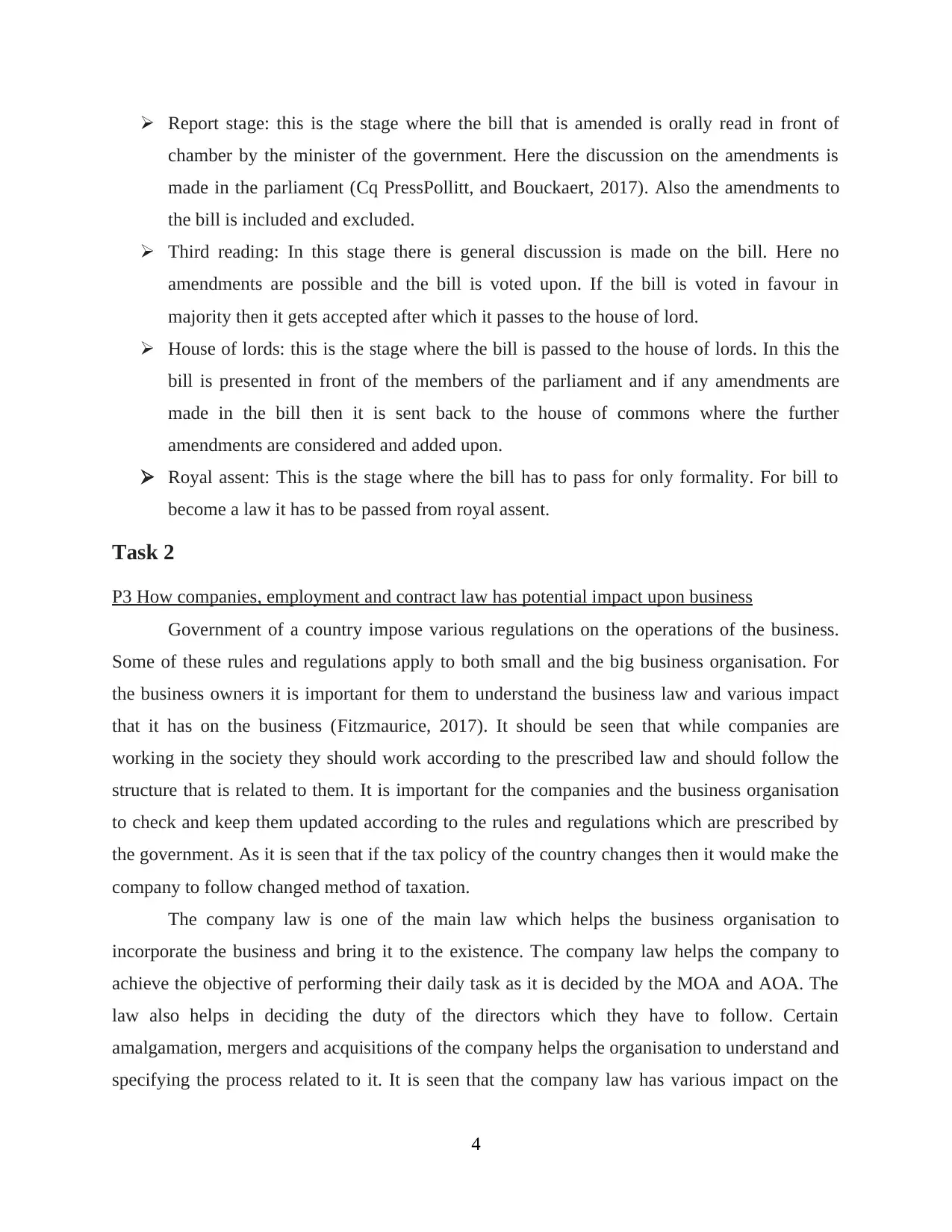
Report stage: this is the stage where the bill that is amended is orally read in front of
chamber by the minister of the government. Here the discussion on the amendments is
made in the parliament (Cq PressPollitt, and Bouckaert, 2017). Also the amendments to
the bill is included and excluded.
Third reading: In this stage there is general discussion is made on the bill. Here no
amendments are possible and the bill is voted upon. If the bill is voted in favour in
majority then it gets accepted after which it passes to the house of lord.
House of lords: this is the stage where the bill is passed to the house of lords. In this the
bill is presented in front of the members of the parliament and if any amendments are
made in the bill then it is sent back to the house of commons where the further
amendments are considered and added upon.
Royal assent: This is the stage where the bill has to pass for only formality. For bill to
become a law it has to be passed from royal assent.
Task 2
P3 How companies, employment and contract law has potential impact upon business
Government of a country impose various regulations on the operations of the business.
Some of these rules and regulations apply to both small and the big business organisation. For
the business owners it is important for them to understand the business law and various impact
that it has on the business (Fitzmaurice, 2017). It should be seen that while companies are
working in the society they should work according to the prescribed law and should follow the
structure that is related to them. It is important for the companies and the business organisation
to check and keep them updated according to the rules and regulations which are prescribed by
the government. As it is seen that if the tax policy of the country changes then it would make the
company to follow changed method of taxation.
The company law is one of the main law which helps the business organisation to
incorporate the business and bring it to the existence. The company law helps the company to
achieve the objective of performing their daily task as it is decided by the MOA and AOA. The
law also helps in deciding the duty of the directors which they have to follow. Certain
amalgamation, mergers and acquisitions of the company helps the organisation to understand and
specifying the process related to it. It is seen that the company law has various impact on the
4
chamber by the minister of the government. Here the discussion on the amendments is
made in the parliament (Cq PressPollitt, and Bouckaert, 2017). Also the amendments to
the bill is included and excluded.
Third reading: In this stage there is general discussion is made on the bill. Here no
amendments are possible and the bill is voted upon. If the bill is voted in favour in
majority then it gets accepted after which it passes to the house of lord.
House of lords: this is the stage where the bill is passed to the house of lords. In this the
bill is presented in front of the members of the parliament and if any amendments are
made in the bill then it is sent back to the house of commons where the further
amendments are considered and added upon.
Royal assent: This is the stage where the bill has to pass for only formality. For bill to
become a law it has to be passed from royal assent.
Task 2
P3 How companies, employment and contract law has potential impact upon business
Government of a country impose various regulations on the operations of the business.
Some of these rules and regulations apply to both small and the big business organisation. For
the business owners it is important for them to understand the business law and various impact
that it has on the business (Fitzmaurice, 2017). It should be seen that while companies are
working in the society they should work according to the prescribed law and should follow the
structure that is related to them. It is important for the companies and the business organisation
to check and keep them updated according to the rules and regulations which are prescribed by
the government. As it is seen that if the tax policy of the country changes then it would make the
company to follow changed method of taxation.
The company law is one of the main law which helps the business organisation to
incorporate the business and bring it to the existence. The company law helps the company to
achieve the objective of performing their daily task as it is decided by the MOA and AOA. The
law also helps in deciding the duty of the directors which they have to follow. Certain
amalgamation, mergers and acquisitions of the company helps the organisation to understand and
specifying the process related to it. It is seen that the company law has various impact on the
4
Paraphrase This Document
Need a fresh take? Get an instant paraphrase of this document with our AI Paraphraser
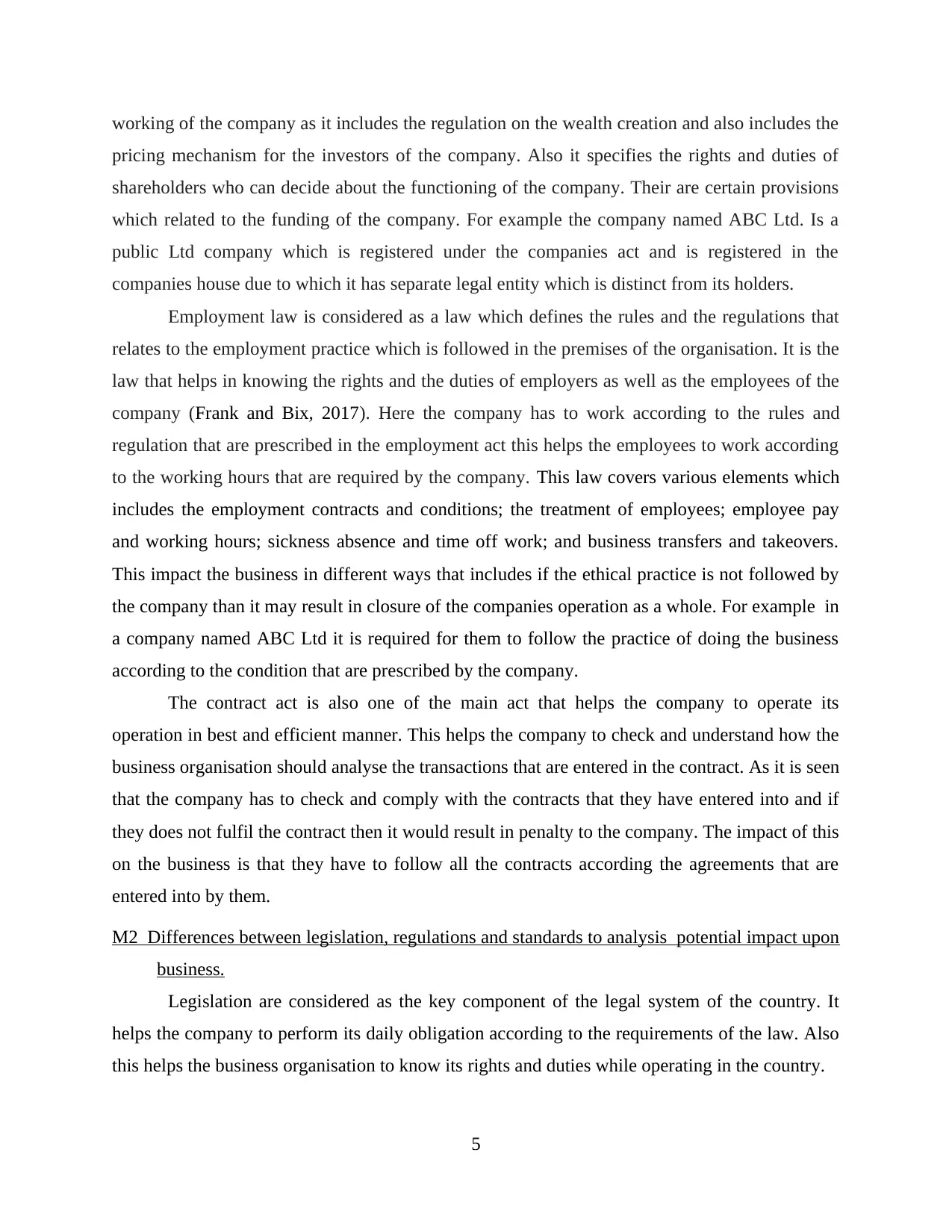
working of the company as it includes the regulation on the wealth creation and also includes the
pricing mechanism for the investors of the company. Also it specifies the rights and duties of
shareholders who can decide about the functioning of the company. Their are certain provisions
which related to the funding of the company. For example the company named ABC Ltd. Is a
public Ltd company which is registered under the companies act and is registered in the
companies house due to which it has separate legal entity which is distinct from its holders.
Employment law is considered as a law which defines the rules and the regulations that
relates to the employment practice which is followed in the premises of the organisation. It is the
law that helps in knowing the rights and the duties of employers as well as the employees of the
company (Frank and Bix, 2017). Here the company has to work according to the rules and
regulation that are prescribed in the employment act this helps the employees to work according
to the working hours that are required by the company. This law covers various elements which
includes the employment contracts and conditions; the treatment of employees; employee pay
and working hours; sickness absence and time off work; and business transfers and takeovers.
This impact the business in different ways that includes if the ethical practice is not followed by
the company than it may result in closure of the companies operation as a whole. For example in
a company named ABC Ltd it is required for them to follow the practice of doing the business
according to the condition that are prescribed by the company.
The contract act is also one of the main act that helps the company to operate its
operation in best and efficient manner. This helps the company to check and understand how the
business organisation should analyse the transactions that are entered in the contract. As it is seen
that the company has to check and comply with the contracts that they have entered into and if
they does not fulfil the contract then it would result in penalty to the company. The impact of this
on the business is that they have to follow all the contracts according the agreements that are
entered into by them.
M2 Differences between legislation, regulations and standards to analysis potential impact upon
business.
Legislation are considered as the key component of the legal system of the country. It
helps the company to perform its daily obligation according to the requirements of the law. Also
this helps the business organisation to know its rights and duties while operating in the country.
5
pricing mechanism for the investors of the company. Also it specifies the rights and duties of
shareholders who can decide about the functioning of the company. Their are certain provisions
which related to the funding of the company. For example the company named ABC Ltd. Is a
public Ltd company which is registered under the companies act and is registered in the
companies house due to which it has separate legal entity which is distinct from its holders.
Employment law is considered as a law which defines the rules and the regulations that
relates to the employment practice which is followed in the premises of the organisation. It is the
law that helps in knowing the rights and the duties of employers as well as the employees of the
company (Frank and Bix, 2017). Here the company has to work according to the rules and
regulation that are prescribed in the employment act this helps the employees to work according
to the working hours that are required by the company. This law covers various elements which
includes the employment contracts and conditions; the treatment of employees; employee pay
and working hours; sickness absence and time off work; and business transfers and takeovers.
This impact the business in different ways that includes if the ethical practice is not followed by
the company than it may result in closure of the companies operation as a whole. For example in
a company named ABC Ltd it is required for them to follow the practice of doing the business
according to the condition that are prescribed by the company.
The contract act is also one of the main act that helps the company to operate its
operation in best and efficient manner. This helps the company to check and understand how the
business organisation should analyse the transactions that are entered in the contract. As it is seen
that the company has to check and comply with the contracts that they have entered into and if
they does not fulfil the contract then it would result in penalty to the company. The impact of this
on the business is that they have to follow all the contracts according the agreements that are
entered into by them.
M2 Differences between legislation, regulations and standards to analysis potential impact upon
business.
Legislation are considered as the key component of the legal system of the country. It
helps the company to perform its daily obligation according to the requirements of the law. Also
this helps the business organisation to know its rights and duties while operating in the country.
5
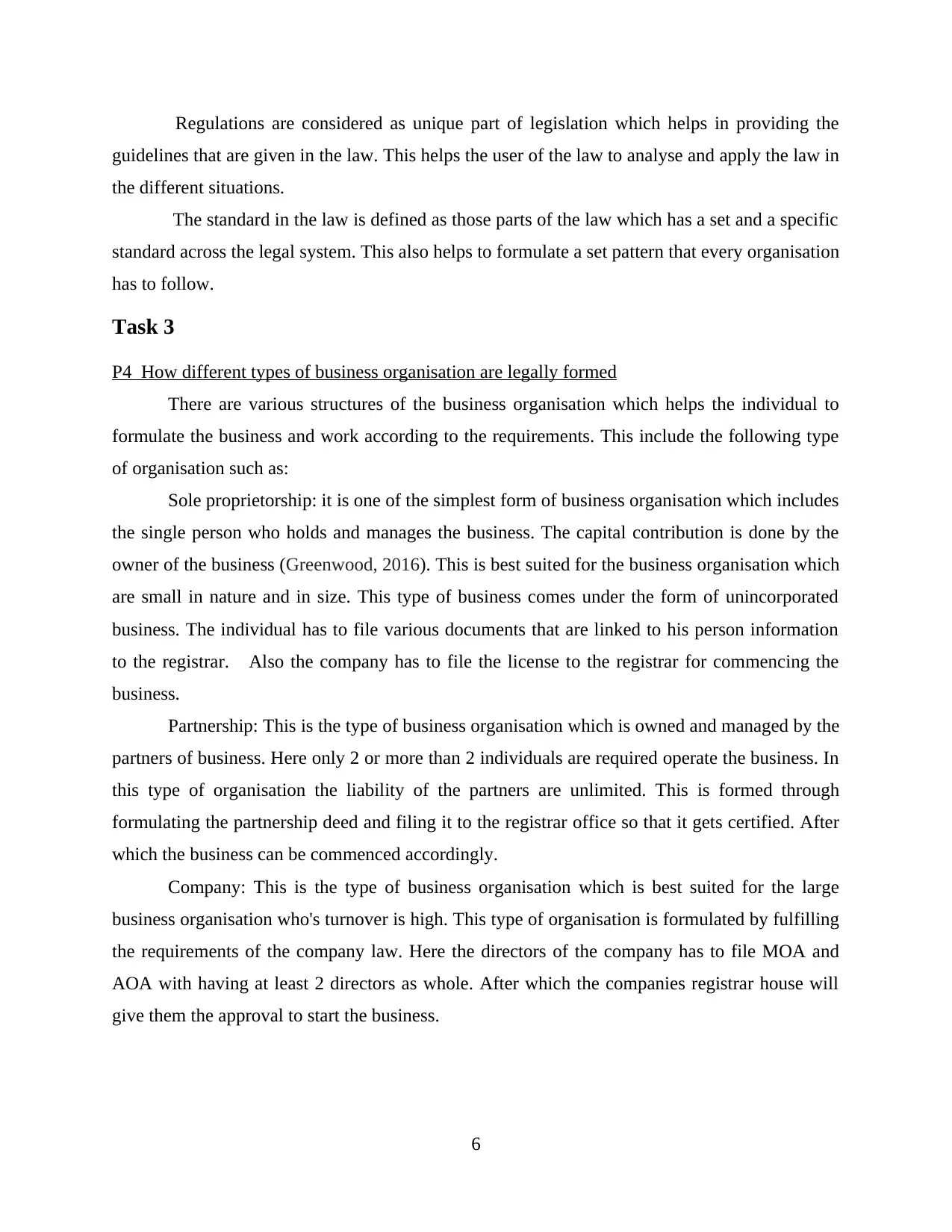
Regulations are considered as unique part of legislation which helps in providing the
guidelines that are given in the law. This helps the user of the law to analyse and apply the law in
the different situations.
The standard in the law is defined as those parts of the law which has a set and a specific
standard across the legal system. This also helps to formulate a set pattern that every organisation
has to follow.
Task 3
P4 How different types of business organisation are legally formed
There are various structures of the business organisation which helps the individual to
formulate the business and work according to the requirements. This include the following type
of organisation such as:
Sole proprietorship: it is one of the simplest form of business organisation which includes
the single person who holds and manages the business. The capital contribution is done by the
owner of the business (Greenwood, 2016). This is best suited for the business organisation which
are small in nature and in size. This type of business comes under the form of unincorporated
business. The individual has to file various documents that are linked to his person information
to the registrar. Also the company has to file the license to the registrar for commencing the
business.
Partnership: This is the type of business organisation which is owned and managed by the
partners of business. Here only 2 or more than 2 individuals are required operate the business. In
this type of organisation the liability of the partners are unlimited. This is formed through
formulating the partnership deed and filing it to the registrar office so that it gets certified. After
which the business can be commenced accordingly.
Company: This is the type of business organisation which is best suited for the large
business organisation who's turnover is high. This type of organisation is formulated by fulfilling
the requirements of the company law. Here the directors of the company has to file MOA and
AOA with having at least 2 directors as whole. After which the companies registrar house will
give them the approval to start the business.
6
guidelines that are given in the law. This helps the user of the law to analyse and apply the law in
the different situations.
The standard in the law is defined as those parts of the law which has a set and a specific
standard across the legal system. This also helps to formulate a set pattern that every organisation
has to follow.
Task 3
P4 How different types of business organisation are legally formed
There are various structures of the business organisation which helps the individual to
formulate the business and work according to the requirements. This include the following type
of organisation such as:
Sole proprietorship: it is one of the simplest form of business organisation which includes
the single person who holds and manages the business. The capital contribution is done by the
owner of the business (Greenwood, 2016). This is best suited for the business organisation which
are small in nature and in size. This type of business comes under the form of unincorporated
business. The individual has to file various documents that are linked to his person information
to the registrar. Also the company has to file the license to the registrar for commencing the
business.
Partnership: This is the type of business organisation which is owned and managed by the
partners of business. Here only 2 or more than 2 individuals are required operate the business. In
this type of organisation the liability of the partners are unlimited. This is formed through
formulating the partnership deed and filing it to the registrar office so that it gets certified. After
which the business can be commenced accordingly.
Company: This is the type of business organisation which is best suited for the large
business organisation who's turnover is high. This type of organisation is formulated by fulfilling
the requirements of the company law. Here the directors of the company has to file MOA and
AOA with having at least 2 directors as whole. After which the companies registrar house will
give them the approval to start the business.
6
⊘ This is a preview!⊘
Do you want full access?
Subscribe today to unlock all pages.

Trusted by 1+ million students worldwide
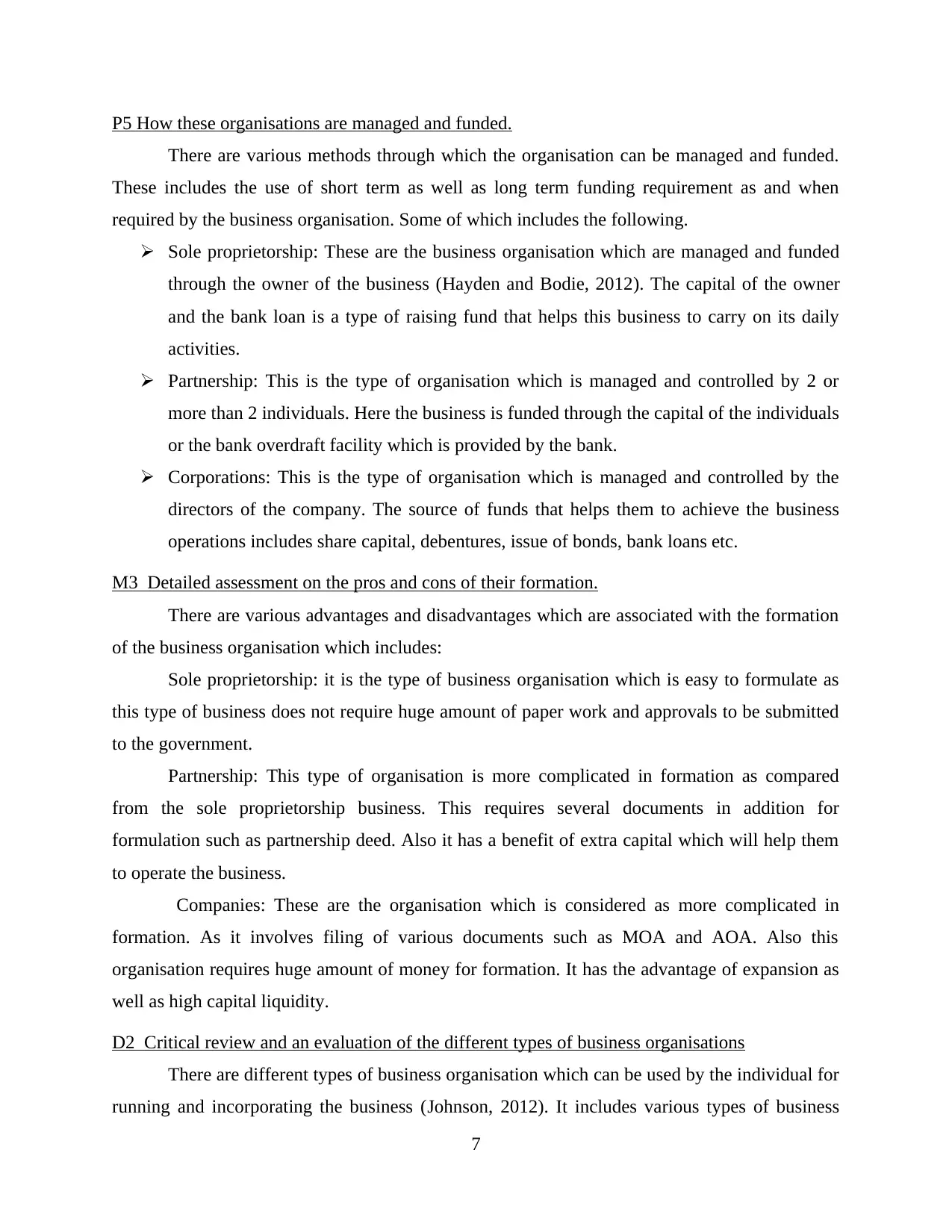
P5 How these organisations are managed and funded.
There are various methods through which the organisation can be managed and funded.
These includes the use of short term as well as long term funding requirement as and when
required by the business organisation. Some of which includes the following.
Sole proprietorship: These are the business organisation which are managed and funded
through the owner of the business (Hayden and Bodie, 2012). The capital of the owner
and the bank loan is a type of raising fund that helps this business to carry on its daily
activities.
Partnership: This is the type of organisation which is managed and controlled by 2 or
more than 2 individuals. Here the business is funded through the capital of the individuals
or the bank overdraft facility which is provided by the bank.
Corporations: This is the type of organisation which is managed and controlled by the
directors of the company. The source of funds that helps them to achieve the business
operations includes share capital, debentures, issue of bonds, bank loans etc.
M3 Detailed assessment on the pros and cons of their formation.
There are various advantages and disadvantages which are associated with the formation
of the business organisation which includes:
Sole proprietorship: it is the type of business organisation which is easy to formulate as
this type of business does not require huge amount of paper work and approvals to be submitted
to the government.
Partnership: This type of organisation is more complicated in formation as compared
from the sole proprietorship business. This requires several documents in addition for
formulation such as partnership deed. Also it has a benefit of extra capital which will help them
to operate the business.
Companies: These are the organisation which is considered as more complicated in
formation. As it involves filing of various documents such as MOA and AOA. Also this
organisation requires huge amount of money for formation. It has the advantage of expansion as
well as high capital liquidity.
D2 Critical review and an evaluation of the different types of business organisations
There are different types of business organisation which can be used by the individual for
running and incorporating the business (Johnson, 2012). It includes various types of business
7
There are various methods through which the organisation can be managed and funded.
These includes the use of short term as well as long term funding requirement as and when
required by the business organisation. Some of which includes the following.
Sole proprietorship: These are the business organisation which are managed and funded
through the owner of the business (Hayden and Bodie, 2012). The capital of the owner
and the bank loan is a type of raising fund that helps this business to carry on its daily
activities.
Partnership: This is the type of organisation which is managed and controlled by 2 or
more than 2 individuals. Here the business is funded through the capital of the individuals
or the bank overdraft facility which is provided by the bank.
Corporations: This is the type of organisation which is managed and controlled by the
directors of the company. The source of funds that helps them to achieve the business
operations includes share capital, debentures, issue of bonds, bank loans etc.
M3 Detailed assessment on the pros and cons of their formation.
There are various advantages and disadvantages which are associated with the formation
of the business organisation which includes:
Sole proprietorship: it is the type of business organisation which is easy to formulate as
this type of business does not require huge amount of paper work and approvals to be submitted
to the government.
Partnership: This type of organisation is more complicated in formation as compared
from the sole proprietorship business. This requires several documents in addition for
formulation such as partnership deed. Also it has a benefit of extra capital which will help them
to operate the business.
Companies: These are the organisation which is considered as more complicated in
formation. As it involves filing of various documents such as MOA and AOA. Also this
organisation requires huge amount of money for formation. It has the advantage of expansion as
well as high capital liquidity.
D2 Critical review and an evaluation of the different types of business organisations
There are different types of business organisation which can be used by the individual for
running and incorporating the business (Johnson, 2012). It includes various types of business
7
Paraphrase This Document
Need a fresh take? Get an instant paraphrase of this document with our AI Paraphraser
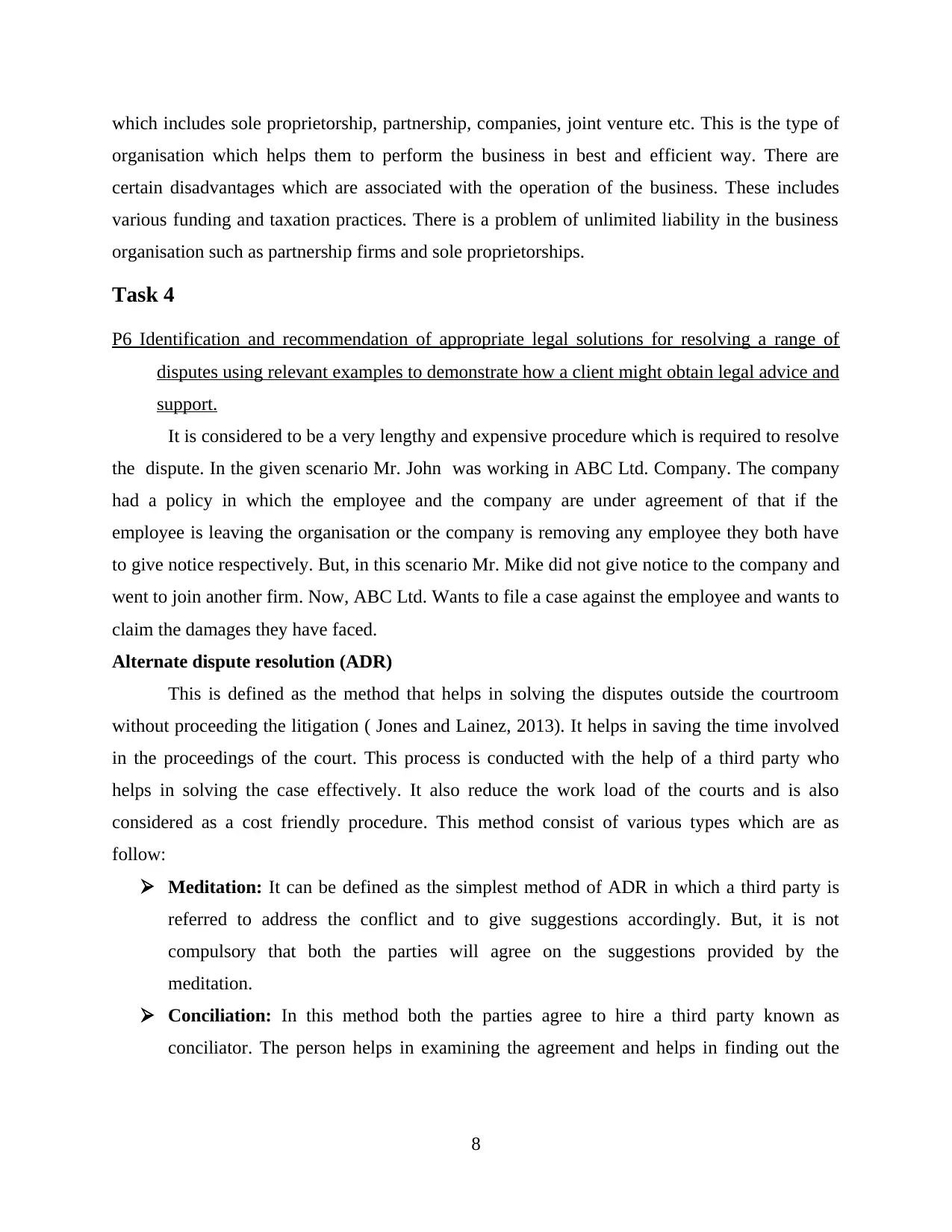
which includes sole proprietorship, partnership, companies, joint venture etc. This is the type of
organisation which helps them to perform the business in best and efficient way. There are
certain disadvantages which are associated with the operation of the business. These includes
various funding and taxation practices. There is a problem of unlimited liability in the business
organisation such as partnership firms and sole proprietorships.
Task 4
P6 Identification and recommendation of appropriate legal solutions for resolving a range of
disputes using relevant examples to demonstrate how a client might obtain legal advice and
support.
It is considered to be a very lengthy and expensive procedure which is required to resolve
the dispute. In the given scenario Mr. John was working in ABC Ltd. Company. The company
had a policy in which the employee and the company are under agreement of that if the
employee is leaving the organisation or the company is removing any employee they both have
to give notice respectively. But, in this scenario Mr. Mike did not give notice to the company and
went to join another firm. Now, ABC Ltd. Wants to file a case against the employee and wants to
claim the damages they have faced.
Alternate dispute resolution (ADR)
This is defined as the method that helps in solving the disputes outside the courtroom
without proceeding the litigation ( Jones and Lainez, 2013). It helps in saving the time involved
in the proceedings of the court. This process is conducted with the help of a third party who
helps in solving the case effectively. It also reduce the work load of the courts and is also
considered as a cost friendly procedure. This method consist of various types which are as
follow:
Meditation: It can be defined as the simplest method of ADR in which a third party is
referred to address the conflict and to give suggestions accordingly. But, it is not
compulsory that both the parties will agree on the suggestions provided by the
meditation.
Conciliation: In this method both the parties agree to hire a third party known as
conciliator. The person helps in examining the agreement and helps in finding out the
8
organisation which helps them to perform the business in best and efficient way. There are
certain disadvantages which are associated with the operation of the business. These includes
various funding and taxation practices. There is a problem of unlimited liability in the business
organisation such as partnership firms and sole proprietorships.
Task 4
P6 Identification and recommendation of appropriate legal solutions for resolving a range of
disputes using relevant examples to demonstrate how a client might obtain legal advice and
support.
It is considered to be a very lengthy and expensive procedure which is required to resolve
the dispute. In the given scenario Mr. John was working in ABC Ltd. Company. The company
had a policy in which the employee and the company are under agreement of that if the
employee is leaving the organisation or the company is removing any employee they both have
to give notice respectively. But, in this scenario Mr. Mike did not give notice to the company and
went to join another firm. Now, ABC Ltd. Wants to file a case against the employee and wants to
claim the damages they have faced.
Alternate dispute resolution (ADR)
This is defined as the method that helps in solving the disputes outside the courtroom
without proceeding the litigation ( Jones and Lainez, 2013). It helps in saving the time involved
in the proceedings of the court. This process is conducted with the help of a third party who
helps in solving the case effectively. It also reduce the work load of the courts and is also
considered as a cost friendly procedure. This method consist of various types which are as
follow:
Meditation: It can be defined as the simplest method of ADR in which a third party is
referred to address the conflict and to give suggestions accordingly. But, it is not
compulsory that both the parties will agree on the suggestions provided by the
meditation.
Conciliation: In this method both the parties agree to hire a third party known as
conciliator. The person helps in examining the agreement and helps in finding out the
8

best possible way for it. It is said to be the similar process like meditation and no
difference is found in them.
Arbitration: In this a arbitrator is selected to deal with the situation in which both the
parties are involved. This process is followed when the dispute is raised and it is facing
problems in finding a solution for it (Kraakman and Hansmann, 2017). This method is of
different nature from the above two as the decision given by the arbitrator is must to be
followed.
Winding Up: It can be defined as one more source to solve dispute between the two
parties. This process consist of appointing a liquidator who will evaluate the value of the total
assets that can be utilised to solve the issues and to pay all the debts. It consists of two parts
which are as follows:
Voluntary winding up: this process is conducted with the consent of the shareholders,
when the company is not sufficient enough to pay their debts to their creditors and they need to
liquidate the company.
Compulsory winding up: This can be proceeded if the order is passed by the court. In this
the Creditors are obligatory to file case against the defaulting company in the court for its
compensation.
M4, D3 Including a comparison and evaluation of the different sources of legal advice and
support.
It is seen that the arbitration and conciliation is one of the most important process that has
been introduced in the legal system of the country (Leiden University PressMishan, 2015). It has
various benefits which are associated with it. Also there are some advantaged over and above
other form of dispute resolving process. As it is more simple as compared from the other process
of judiciary and also is time effective as it takes less time for solving the dispute.
Conclusion
This has been concluded from the above report that business law is one of the very
essential law that helps the business organisation to perform its functions as per the requirement
of law. Also it is seen that there are different sources of UK constituency through which the legal
system is formulated. Also there are various types of organisation which helps them to
incorporate the business and fund them for expansion purpose.
9
difference is found in them.
Arbitration: In this a arbitrator is selected to deal with the situation in which both the
parties are involved. This process is followed when the dispute is raised and it is facing
problems in finding a solution for it (Kraakman and Hansmann, 2017). This method is of
different nature from the above two as the decision given by the arbitrator is must to be
followed.
Winding Up: It can be defined as one more source to solve dispute between the two
parties. This process consist of appointing a liquidator who will evaluate the value of the total
assets that can be utilised to solve the issues and to pay all the debts. It consists of two parts
which are as follows:
Voluntary winding up: this process is conducted with the consent of the shareholders,
when the company is not sufficient enough to pay their debts to their creditors and they need to
liquidate the company.
Compulsory winding up: This can be proceeded if the order is passed by the court. In this
the Creditors are obligatory to file case against the defaulting company in the court for its
compensation.
M4, D3 Including a comparison and evaluation of the different sources of legal advice and
support.
It is seen that the arbitration and conciliation is one of the most important process that has
been introduced in the legal system of the country (Leiden University PressMishan, 2015). It has
various benefits which are associated with it. Also there are some advantaged over and above
other form of dispute resolving process. As it is more simple as compared from the other process
of judiciary and also is time effective as it takes less time for solving the dispute.
Conclusion
This has been concluded from the above report that business law is one of the very
essential law that helps the business organisation to perform its functions as per the requirement
of law. Also it is seen that there are different sources of UK constituency through which the legal
system is formulated. Also there are various types of organisation which helps them to
incorporate the business and fund them for expansion purpose.
9
⊘ This is a preview!⊘
Do you want full access?
Subscribe today to unlock all pages.

Trusted by 1+ million students worldwide
1 out of 15
Related Documents
Your All-in-One AI-Powered Toolkit for Academic Success.
+13062052269
info@desklib.com
Available 24*7 on WhatsApp / Email
![[object Object]](/_next/static/media/star-bottom.7253800d.svg)
Unlock your academic potential
Copyright © 2020–2025 A2Z Services. All Rights Reserved. Developed and managed by ZUCOL.



